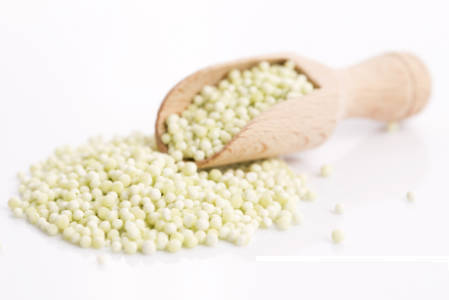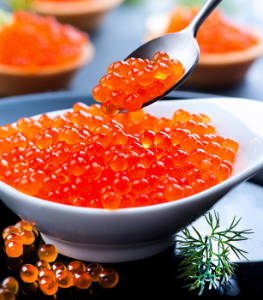Miscellaneous Category

Includes thickeners and food wrappers
squash blossoms
These make exquisite garnishes, but they can also be stuffed with fillings and fried, or else sautéed very briefly and put into omelettes or quesadillas. The best source of the blossoms is a garden, but non-gardeners can sometimes find them in farmers' markets or specialty markets. They don't store well, so try to use the blossoms soon after you get them.
Learn moreStarch thickeners
Notes: These silky powders are used to thicken sauces, gravies, pie fillings, and puddings. They're popular because they thicken without adding fat or much flavor. To avoid lumps, mix the starch with an equal amount of cold liquid until it forms a paste, then whisk it into the liquid you're trying to thicken. Once the thickener is added, cook it briefly to remove the starchy flavor. Don't overcook--liquids thickened with some starches will thin again if cooked too long or at too high a temperature. Cornstarch, arrowroot, and tapioca are the most popular starch thickeners. They have different strengths and weaknesses, so it's a good idea to stock all three in your pantry. Starch thickeners give food a transparent, glistening sheen, which looks nice in a pie filling, but a bit artificial in a gravy or sauce. If you want high gloss, choose tapioca or arrowroot. If you want low gloss, choose cornstarch. Cornstarch is the best choice for thickening dairy-based sauces. Arrowroot becomes slimy when mixed with milk products. Choose arrowroot if you're thickening an acidic liquid. Cornstarch loses potency when mixed with acids. Sauces made with cornstarch turn spongy when they're frozen. If you plan to freeze a dish, use tapioca starch or arrowroot as a thickener. Starch thickeners don't add much flavor to a dish, although they can impart a starchy flavor if they're undercooked. If you worried that your thickener will mask delicate flavors in your dish, choose arrowroot. It's the most neutral tasting of the starch thickeners. Tapioca starch thickens quickly, and at a relatively low temperature. It's a good choice if you want to correct a sauce just before serving it.
Learn morestevia extract
This has been touted has a healthful alternative to non-nutritive artificial sweeteners. It's quite sweet, but has a bitter aftertaste. Look for it in health food stores.
Learn moresui kow wrappers
These are similar to potsticker wrappers, but they're intended to be used in soups. While assembling the dumplings, keep the stack of wrappers moist by covering them with a damp towel. Seal the dumplings with a "glue" made with cornstarch and water. Look for stacks of these wrappers in the refrigerator cases of Asian markets. Store them in the refrigerator or freezer, but let them come to room temperature before using.
Learn moresweet rice flour
This thickener has the virtue of remaining stable when frozen. It's often used to make Asian desserts. Don't confuse sweet rice flour with ordinary rice flour. Look for it in Asian markets.
Learn moretapioca
These are small beads of tapioca that are used to make tapioca pudding. The beads don't dissolve completely, so they end up as small, squishy, gelatinous balls that are suspended in the pudding. Don't confuse this with instant tapioca, which is granulated and often used to thicken fruit pie fillings, or with pearl tapioca, which has much larger balls.
Learn moretapioca pearls
These round pellets are made from cassava roots. Asians use them to make puddings and a beverage called bubble tea. You can also use them to make tapioca pudding, though it's faster and easier to use instant or regular tapioca. The pearls are normally soaked for at least a few hours before they're added to a recipe.
Learn moretapioca starch
Tapioca is a good choice for thickening pie fillings, since it thickens at a lower temperature than cornstarch, remains stable when frozen, and imparts a glossy sheen. Many pie recipes call for instant tapioca instead of tapioca starch, but instant tapioca doesn't dissolve completely and leaves small gelatinous blobs suspended in the liquid. This isn't a problem in a two-crust pies, but the blobs are more noticeable in single-crust pies. Tapioca starch is finely ground so that it dissolves completely, eliminating the gelatinous blob problem. The starch is also sometimes used to thicken soups, stews, and sauces, but the glossy finish looks a bit unnatural in these kinds of dishes. It works quickly, though, so it's a good choice if you want to correct a sauce just before serving it. Some recipes for baked goods also call for tapioca flour because it imparts a chewier texture.
Learn moretarama
Greek markets often carry jars of this pink cod roe. It's often used to make taramasalata, which is tarama mixed with a filler (like bread crumbs), oil, and seasonings.
Learn morethickeners
Thickeners add substance and body to sauces, stews, soups, puddings, pie fillings, and other dishes. Tips: Before you add a thickener to a sauce, skim the fat from the top. Once you've added the thickener, the fat will be harder to remove. Flour is a good thickener for gravies, gumbos, and stews, since it gives them a smooth, velvety texture. It's best to mix it with fat first, either by making a roux or beurre manié, or by flouring and frying stew meat before adding a liquid to the pot. If you wish to cut fat from your diet, you can instead mix the flour with water and add it to the sauce, but you'll need to cook it for quite awhile to get rid of the starchy, raw flour taste. Sauces thickened with flour become opaque, and they may become become thin again if they're cooked too long or if they're frozen and then thawed. Starch thickeners like cornstarch are mixed with an equal amount of cold water, then added to warm liquids to thicken them. They're a good choice if you want a low-fat, neutral-tasting thickener. They give dishes a glossy sheen, which looks wonderful if you're making a dessert sauce or pie filling, but a bit artificial in a gravy or stew. If you get lumps in your sauce from a thickener, blend the sauce in a blender or food processor until it's smooth. Cereal grains like oatmeal, couscous, soup pasta, farina, are often used to thicken soups. Reduction is a slow but low-fat way of thickening sauces and concentrating flavors. Just cook down the sauce in an uncovered pan until it's thickened to your liking. Meat and fish glaces are a time-consuming--or expensive, if you buy them ready-made--way of thickening and enriching sauces. They're made by reducing stocks until they're thick and gelatinous. A good way to thicken soups or stews is to add grated starchy vegetables, or to purée the vegetables in the sauce. Nuts make good, flavorful thickeners for stews, though they're often expensive and high in fat. Just grind them down to a flour or butter, and add them to the dish. Egg yolks add a silky, velvety texture to soups and sauces, but they'll turn into scrambled eggs if they're not introduced carefully into the hot liquid. Cream, once reduced, gives sauces a rich texture and flavor as it thickens them, but it's high in fat. To make a low-fat cream sauce, use evaporated milk mixed with a starch thickener. Yogurt is a popular soup thickener in Eastern Europe and the Middle East.
Learn moreThickenThin™
This thickener has no calories, fat, or carbohydrates. It's great for thickening gravies, sauces, and soups, but it won't set up sufficiently to make puddings or custards. A little goes a long way, so use about half as much as you would a starch thickener.
Learn moreti leaves
South Pacific islanders use these to wrap food and to line the imu pits in which they roast pigs.
Learn morevesiga
Vesiga is the spinal cord of a European sturgeon. It is considered a delicacy in Russia. Coulibiac is a Russian dish that features vesiga.
Learn morewater chestnut starch
Asian cooks often dredge foods in this before frying them, because it gives fried foods a crisp, nutty coating. It can also be used as a thickener. Look for it in Asian markets and health food stores. Don't confuse this with chestnut flour.
Learn morewax paper
Invented by Thomas Edison, this is paper that's coated with paraffin wax to make it resistant to moisture. To use wax paper as a cake pan liner, place the pan on the paper, trace its outline, then cut it out and place it in the pan.
Learn morewine ball
These are balls of brewer's yeast that are sold in Asian markets. They're used to make wine.
Learn morewonton wrappers
Wontons are the Chinese answer to ravioli--small packets of meat encased in a thin noodle wrapper. The wrappers are made of flour, eggs, and water, and, once filled with meat, can be easily folded and pinched into shape. While assembling the wontons, keep the stack of wrappers moist by covering them with a damp towel. You can seal the dumplings with a "glue" made with cornstarch and water. The wrappers come in different thicknesses. The thin ones work best in soups, while the thicker ones are best for frying. Look for stacks of them wrapped in plastic in the refrigerator cases of Asian markets. Store them in the refrigerator or freezer, but let them come to room temperature before using.
Learn morexanthan
Derived from corn sugar, xanthan gum is used as a thickener, stabilizer, and emulsifier.
Learn moreyam cake
Yam cakes are made by combining yams, dried prawns and rice flower. Then shaping it and steaming it.
Learn more


























































































































































































































































































































































